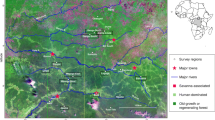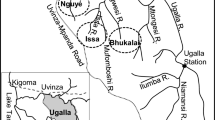Abstract
Details are presented relating to chimpanzees' choices between two sympatric species of termites,Macrotermes lillijeborgi andM. vitrialatus, as food in the Campo Animal Reserve, southwest Cameroon, West Africa. An attempt was made to determine the various factors that affected such choices. The two species of termites seemed to have almost the same value in terms of ecological factors. However, chimpanzees fed almost exclusivelyonM. lillijeborgi, using digging sticks and fisching probes, during the study period which extended from the end of August to the middle of January, with their feeding activity showing peak at the beginning of the rainy season. By contrast,M. vitrialatus was rarely eaten in spite of the ease with which such prey could be obtained, namely, by desctruction of termite mounds by hand, without the need for tools. The reason that the chimpanzees discriminated between the two species of termite cannot be explained in terms of ecological factors such as size of prey, seasonal differences in termite activity, etc. Sticks used as tools were fairly uniform in size and character, mainly because of physical constraints related to the structure of termite mounds, and the brush-like ends of sticks seemed to be incidentaly byproducts of the chimpanzee's choice of plant species. Ecological factors could provide chimpanzees with a basis for the use of some kind of tool and help them modify it, while other factors, for example, something akin to leisure or the chimpanzee's interest in use of a tool, could provide an opportunity for inventing some tool-using behavior or for maintaining such behavior. These different factors, not being exclusive of one another, might affect the invention and maintenance of tool using-behavior at different phases. It is possible that chimpanzee's choice of prey may not always be the most efficient or appropriate in a given ecological situation.
Similar content being viewed by others
References
Goodall J., 1986.The Chimpanzees of Gombe. Cambridge, The Belknap Press of Harvard University Press.
Hladik C.M., 1977.Chimpanzees of Gabon and chimpanzees of Gombe: some comparative data on the diet. In: T. H. Clutton-Brock, ed. Primate ecology, pp. 481–501. London, Academic Press.
Hoshino J., 1985.Feeding Ecology of Mandrills (Mandillus sphinx)in Campo Animal Reserve, Cameroon. Primates, 26: 248–273.
Jones C. &Sabater Pi J., 1969.Sticks used by chimpanzees in Rio Muni, West Africa. Nature, 223: 100–101.
McBeath N.M. &McGrew W.C., 1982.Tools used by wild chimpanzees to obtain termites at Mt Assirik, Senegal: the influence of habitat. Journal of Human Evolution, 11: 65–72.
McGrew W.C., Tutin C.E.G. &Baldwin P.J., 1979.Chimpanzees, tools, and termites: cross-cultural comparisons of Senegal, Tanzania, and Rio Muni. Man, 14: 184–214.
McGrew W.C., 1983.Animal foods in the diets of wild chimpanzees (Pan troglodytes):why cross-cultural variation? Journal of Ethology, 1: 46–61.
McGrew W.C. &Collins M., 1985.Tool use by wild chimpanzees (Pan troglodytes) to obtain termites (Macrotermes herus) in the Mahale mountains, Tanzania. American Journal of Primatology, 9: 47–62.
Nishida T., 1977. The and-gathering behaviour by the use of tools among wild chimpanzees of the Mahale Mountains. Joural of Human Evolution, 2: 357–370.
Nishida T. &Uehara S., 1980.Chimpanzees, tools, and termites: another example from Tanzania. Current Anthropology, 5: 671–672.
Ruelle J.E., 1970.A revision of the termites of the genus Macrotermesfrom the Ethiopian region (Isoptera: Termitidae). The Bulletin of the British Museum (Natural History), 24: 365–444.
Sabater Pi J., 1974.At elementary industry of the chimpanzees in the Okorobiko Mountains, Rio Muni (Republic of Equatorial Guinea), West Africa. Primates, 15: 351–364.
Sugiyama Y., 1985.The brush-stick of chimpanzees found in south-west Cameroon and their cultural characteristics. Primates, 26: 361–374.
Sugiyama Y. &Koman J., 1979.Tool-using and-making behavior in wild chimpanzees at Bossou, Guinea. Primates, 20: 513–524.
Suzuki A., 1966.On the insect-eating habits among wild chimpanzees living in the savanna wooland of western Tanzania. Primates, 7: 481–487.
Teleki G., 1974.Chimpanzee subsistence technology: materials and skills. Journal of Human Evolution, 3: 575–594.
Uehara S., 1982.Seasonal Changes in the techniques employed by wild chimpanzees in the Mahale mountains. Tanzania, to feed on termites (Pseudacanthotermes spiniger). Folia Primatologica, 37: 44–76.
Author information
Authors and Affiliations
Rights and permissions
About this article
Cite this article
Muroyama, Y. Chimpanzees' choices of prey between two sympatric species ofMacrotermes in the Campo Animal Reserve, Cameroon. Hum. Evol. 6, 143–151 (1991). https://doi.org/10.1007/BF02435614
Received:
Accepted:
Issue Date:
DOI: https://doi.org/10.1007/BF02435614




